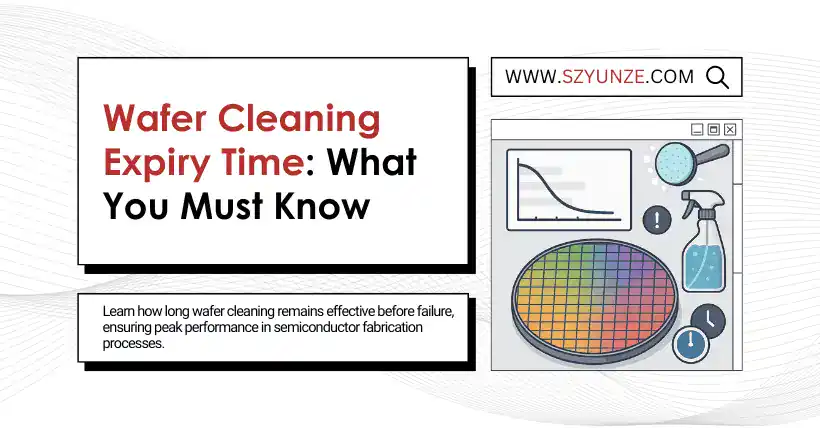The failure time after wafer cleaning (i.e., the time from cleaning until surface contamination or oxidation reappears) depends on various factors, including the cleaning process, environmental conditions, wafer surface materials, and subsequent handling. Below is a brief analysis:
01
Typical Wafer Cleaning Failure Time Range
At normal temperature and pressure: In a clean and dry environment, the wafer surface may remain clean for several hours to days, depending on environmental humidity, particle concentration, and surface adsorption characteristics.
High humidity environment: If the humidity is high (e.g., >50%), the wafer surface may adsorb moisture or airborne contaminants (e.g., particles, organics) within a few hours, leading to failure.
Special gas environment: Under nitrogen (N₂) or inert gas protection, the failure time can be extended to several days or longer, due to significantly reduced oxidation and contamination rates.
02
Key Factors Affecting Failure Time
Surface cleanliness: Residual chemicals (e.g., cleaning solution, DI water) or particles accelerate contamination or corrosion.
Environmental control:
- Cleanliness: ISO Class 4–5 cleanrooms can significantly extend failure time.
- Temperature and humidity: High temperature and humidity promote oxidation and adsorption.
- Airflow rate: Low airflow reduces particle deposition, but excessive airflow may introduce contamination.
Wafer material: A hydrogen-terminated silicon surface (e.g., after HF cleaning) can delay oxidation but degrades over time.
Storage method: Using FOUPs (Front Opening Unified Pods) or sealed packaging can slow down contamination.
03
Reference Failure Times in Common Scenarios
| Scenario | Time to Degradation | Key Influencing Factors |
|---|---|---|
| Ambient Atmosphere (Unpackaged) | Few hours to 1 day | Humidity, Particle Concentration, Surface Adsorption |
| Nitrogen Cabinet Storage (Dry Environment) | 1 to 3 days | Nitrogen Purity, Temperature and Humidity Control |
| Vacuum-Sealed Packaging | Few days to several weeks | Gas Tightness of Packaging Materials, Residual Gases |
| Not Fully Dried After Cleaning | Within a few hours | Residual Water Stains Causing Oxidation or Particle Adsorption |
04
Measures to Extend Failure Time
- Optimize cleaning process: Ensure complete removal of residues (e.g., DI water rinse, IPA drying).
- Environmental control: Operate in ISO Class 4–5 cleanrooms; control temperature and humidity (recommended <40% RH).
- Inert gas protection: Use nitrogen purge or store in nitrogen-filled FOUPs.
- Fast transition: Proceed quickly to the next process step (e.g., drying, etching, or deposition) after cleaning to minimize exposure time.
- Surface passivation: Use HF treatment to form a hydrogen-terminated layer to delay oxidation.
The failure time after wafer cleaning is usually several hours to a few days, depending on the environment and storage conditions. In actual production, cleaning-to-process time should be minimized (e.g., <1 hour) to avoid contamination or oxidation that could affect yield.

Disclaimer:
- This channel does not make any representations or warranties regarding the availability, accuracy, timeliness, effectiveness, or completeness of any information posted. It hereby disclaims any liability or consequences arising from the use of the information.
- This channel is non-commercial and non-profit. The re-posted content does not signify endorsement of its views or responsibility for its authenticity. It does not intend to constitute any other guidance. This channel is not liable for any inaccuracies or errors in the re-posted or published information, directly or indirectly.
- Some data, materials, text, images, etc., used in this channel are sourced from the internet, and all reposts are duly credited to their sources. If you discover any work that infringes on your intellectual property rights or personal legal interests, please contact us, and we will promptly modify or remove it.



